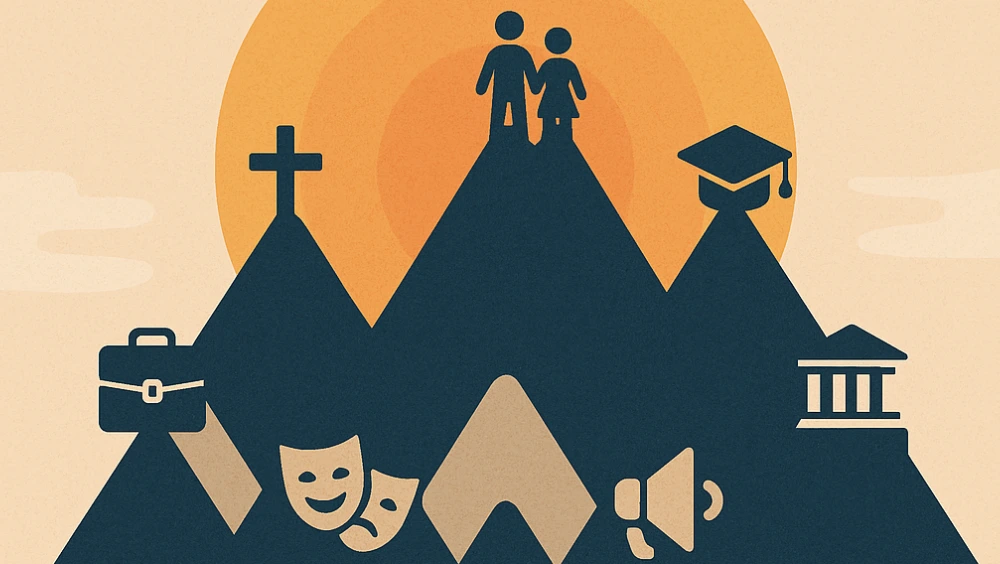Discover the 7 Mountains of Influence theory and how these cultural spheres shape society. Learn about religion, family, education, government, media, arts, and business leadership roles.
Every society has certain areas that shape how people think, act, and live. These areas hold incredible power over culture and daily life. The “7 Mountains of Influence” concept identifies the key spheres that control and influence modern society.
This theory suggests that whoever controls these seven areas essentially controls the culture. Understanding these mountains helps explain how change happens in society and where true influence lies. Let’s explore each mountain and see how they work together to shape our world.
What Is the 7 Mountains of Influence Theory?
The 7 Mountains of Influence theory identifies seven key areas of society that have the most impact on culture and values. These “mountains” represent the primary pillars that support civilization. They are:
- Religion
- Family
- Education
- Government
- Media
- Arts and Entertainment
- Business
The concept gained popularity in Christian circles during the early 2000s, but the idea applies to understanding any society’s power structures. Each mountain influences the others, creating a web of cultural impact.
Think of these mountains as the control centers of society. The people who lead in these areas shape what others believe, value, and pursue. They set trends, make rules, and influence millions of decisions.
The First Mountain: Religion
Religion has shaped human civilization for thousands of years. It provides moral frameworks, answers life’s big questions, and creates communities around shared beliefs.
Religious leaders influence how people view right and wrong. They guide major life decisions like marriage, parenting, and career choices. Religious institutions often run schools, hospitals, and charity organizations.
In America, religious influence shows up in many ways. Churches provide community centers and social services. Religious values influence political debates about family issues, healthcare, and social policies.
Different religions compete for influence in this mountain. Christianity, Islam, Judaism, Buddhism, and other faiths all seek to shape society according to their teachings. Even secular worldviews like atheism or humanism compete in this space.
The decline of traditional religious influence in some Western countries has created space for new spiritual movements and philosophies to gain ground.
The Second Mountain: Family
Family structures form the basic building blocks of society. How families operate affects everything from economic patterns to voting behaviors.
Strong families typically produce stable communities. They teach values, provide emotional support, and prepare children for adult responsibilities. Family breakdown often leads to social problems like poverty, crime, and educational struggles.
Different family models compete for acceptance in modern society. Traditional nuclear families, single-parent households, blended families, and alternative family structures all seek cultural validation.
Family influencers include parenting experts, relationship counselors, and family advocacy groups. They shape ideas about child-rearing, marriage, and family responsibilities through books, seminars, and media appearances.
Government policies about marriage, divorce, child custody, and family benefits directly impact this mountain. Tax codes, education policies, and social services all reflect society’s values about family importance.
The Third Mountain: Education
Education shapes how entire generations think and view the world. Schools don’t just teach facts—they influence values, worldviews, and future career paths.
Teachers, professors, and educational administrators wield enormous influence over young minds. Curriculum choices determine what students learn about history, science, literature, and social issues.
The education mountain includes public schools, private schools, homeschooling, and higher education. Each sector promotes different approaches to learning and different sets of values.
Educational influence extends beyond classrooms. Textbook publishers, testing companies, and educational technology firms all shape how learning happens. Online education platforms now reach millions of students worldwide.
Political battles often focus on education because people understand its power. Debates about school choice, curriculum content, and funding reflect deeper disagreements about society’s direction.
The Fourth Mountain: Government
The government creates and enforces the rules that everyone must follow. Laws, regulations, and policies directly impact daily life for millions of people.
Political leaders influence society through legislation, court decisions, and executive actions. They decide how tax money gets spent, what behaviors are legal, and how disputes get resolved.
Government influence operates at multiple levels. Federal, state, and local governments all make decisions that affect citizens. International agreements and treaties also shape domestic policies.
The judicial system interprets laws and sets legal precedents. Supreme Court decisions can change society overnight by redefining rights and responsibilities.
Government employees, from police officers to social workers, implement policies that directly touch people’s lives. Their decisions about enforcement and service delivery affect millions of interactions.
The Fifth Mountain: Media
The media controls the flow of information in society. News outlets, social media platforms, and communication networks decide what stories get told and how they’re presented.
Journalists, editors, and media executives shape public opinion through story selection and presentation. They decide which issues get attention and which get ignored.
Traditional media like newspapers, television, and radio still influence millions of people. But social media platforms now compete for attention and influence. Facebook, Twitter, YouTube, and TikTok reach billions of users worldwide.
Media influence extends to how stories are framed. The same event can look completely different depending on which details get emphasized and which get downplayed.
Entertainment media also belong to this mountain. Movies, TV shows, and streaming content shape cultural values and normalize certain behaviors and attitudes.
The Sixth Mountain: Arts and Entertainment
Arts and entertainment influence culture by shaping emotions, imagination, and cultural ideals. They make abstract ideas feel real and personal.
Artists, musicians, actors, and writers create content that influences how people see themselves and their world. Popular culture often reflects and shapes societal values simultaneously.
Hollywood movies reach global audiences and export American cultural values worldwide. Music artists influence fashion, language, and lifestyle choices among young people.
Visual artists and designers shape the environments where people live and work. Architecture influences how communities develop and how people interact with each other.
Sports and entertainment celebrities become role models and cultural influencers. Their personal choices and public statements can influence millions of fans.
The rise of social media has democratized entertainment influence. Now, individual creators can reach massive audiences without traditional gatekeepers.
The Seventh Mountain: Business
Business and economics drive much of what happens in society. Companies create jobs, develop products, and influence lifestyle choices through marketing and innovation.
Business leaders make decisions that affect entire communities. Where they locate factories, what technologies they develop, and how they treat employees all have broad social impacts.
Large corporations wield enormous influence through their size and reach. Tech companies like Google, Apple, and Amazon shape how people communicate, shop, and access information.
Economic systems and policies affect every other mountain. How societies organize their economies influences education funding, government services, and family stability.
Business influence extends to corporate social responsibility and philanthropy. Many companies now try to influence social issues through their policies and charitable giving.
Entrepreneurship and innovation drive cultural change by creating new possibilities and disrupting old systems.
How the Mountains Work Together
These 7 mountains of influence don’t operate independently. They constantly influence each other in complex ways.
For example, media coverage affects political outcomes, which influence government policies, which impact business regulations, which affect family economics, which influence educational choices.
Religious values might influence family structures, which affect educational priorities, which shape business practices, which influence media content, which affects political debates.
Understanding these connections helps explain why cultural change often happens slowly. Each mountain has its power centers and resistance to change.
Real-World Examples of the 7 Mountains of Influence
Technology’s Cross-Mountain Impact
The rise of smartphones demonstrates how one innovation can influence multiple markets. Technology companies (business) created devices that changed how families communicate, how students learn (education), how politicians campaign (government), how news spreads (media), and how people consume entertainment (arts).
Social Movement Success
Successful social movements typically influence multiple movements simultaneously. The civil rights movement worked through churches (religion), legal challenges (government), media coverage, cultural expression (arts), and economic boycotts (business).
Cultural Shifts
Major cultural shifts usually involve changes across several mountains. The women’s movement influenced family structures, educational opportunities, business practices, political representation, media coverage, and religious interpretations.
Why Understanding These Mountains Matters
For Leaders
Leaders who understand the 7 mountains of influence can create more effective strategies for change. Instead of focusing on just one area, they can coordinate efforts across multiple mountains.
For Citizens
Understanding these influence centers helps people make better decisions about where to invest their time and energy. It also helps explain why certain changes happen quickly while others take decades.
For Organizations
Organizations can better achieve their goals by understanding how the different 7 mountains of influence affect their work. A charity might need to engage with media, government, and business to create lasting change.
Challenges and Criticisms
Some critics argue that the seven mountains model oversimplifies complex social dynamics. Real influence often happens through informal networks and relationships that don’t fit neatly into these categories.
Others worry about the political implications of the theory. Different groups might use it to justify efforts to “capture” certain mountains for their purposes.
The model may also underestimate how quickly things can change in the digital age. Social media and technology have created new forms of influence that don’t fit traditional categories.
The Future of Cultural Influence
The 7 mountains of influence model will likely evolve as society changes. Technology might become its mountain, or existing mountains might merge or split.
Digital platforms now cross multiple mountains. A single app might influence business, media, education, and entertainment simultaneously.
Global connectivity means that influence increasingly crosses national boundaries. Leaders in one country can now influence mountains in other countries through digital platforms.
Younger generations might value different types of influence than older ones. Traditional institutions may need to adapt or risk losing their positions on various mountains.
Practical Applications
For Aspiring Leaders
If you want to create cultural change, consider which mountains are most relevant to your goals. Develop expertise and relationships in those areas.
For Understanding Current Events
Use the 7 mountains of influence framework to analyze news stories and social trends. Ask which mountains are involved and how they’re influencing each other.
For Personal Development
Consider how different mountains influence your own life. Are you being intentional about the influences you allow to shape your thinking?
Conclusion
The 7 Mountains of Influence provide a useful framework for understanding how culture and society operate. Religion, family, education, government, media, arts, and business all play crucial roles in shaping the world we live in.
These mountains constantly influence each other in complex ways. Understanding their interactions helps explain how change happens and where true power lies in society.
While the model has limitations, it offers valuable insights for leaders, citizens, and organizations who want to create positive change. The key is recognizing that lasting cultural influence usually requires engaging with multiple mountains rather than focusing on just one.
The future will likely bring changes to how these mountains operate, but their fundamental importance to society will probably remain. The people and organizations that understand and engage with these influence centers will continue to shape the world for generations to come.





